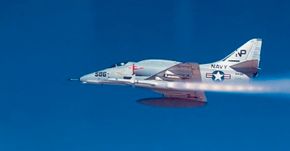Key Takeaways
- The Douglas A-4 Skyhawk is a compact and versatile military aircraft used primarily by the United States Navy and Marines.
- It gained fame for its small size, simplicity and effectiveness in close air support and ground-attack missions.
- Despite its small stature, the A-4 Skyhawk played a significant role in various conflicts, showcasing its agility and firepower.
Known as "Heinemann's Hot Rod" in affectionate tribute to its chief designer, the great Ed Heinemann, the tiny but potent Douglas A-4 Skyhawk remained in continuous production for 25 years, longer than any other warplane. It was one of the primary U.S. Navy and Marine weapons during the Vietnam War, and was used with great effect by other nations, most especially by Israel.
Advertisement
Heinemann believed in "simplifying and adding lightness" when it came to aircraft design. He had startled the Navy when he proposed a new attack plane that weighed only one-half the gross weight of the Navy specification. Using a delta-wing design with conventional tail surfaces, Heinemann was able to create a lightweight attack fighter that combined speed, range, and firepower into a tiny package.
The prototype Douglas A-4 Skyhawk first flew on June 22, 1954, and had a trouble-free test period, during which it set a new world's speed record for the 500-kilometer, closed-circuit course of 695 miles per hour. This was at a time when the Navy's primary attack plane, the excellent Douglas Skyraider, topped out at 321 mph.
The Douglas A-4 Skyhawk was a marvelous combat plane: tough and able to take punishment. More than 29 variants of the Skyhawk were used by the United States Navy and Marines, and it received further modifications while serving with foreign countries. It was especially effective for Israel during the 1973 Yom Kippur War.
Oddly enough, some of the A-4's most important service came in two noncombat arenas. First, it served as the official aircraft of the Blue Angels, the Navy aerial demonstration team, where its aerobatic ability was legendary. Then it operated in the Navy's Top Gun program as an "enemy" fighter because its small size, maneuverability, and speed made it a good stand-in for the Soviet MiG-21 in mock combat. In peace and in war, there was no substitute for the Douglas A-4 Skyhawk.
Advertisement
